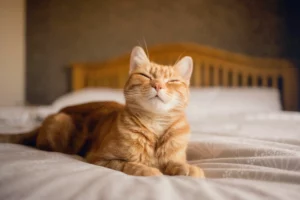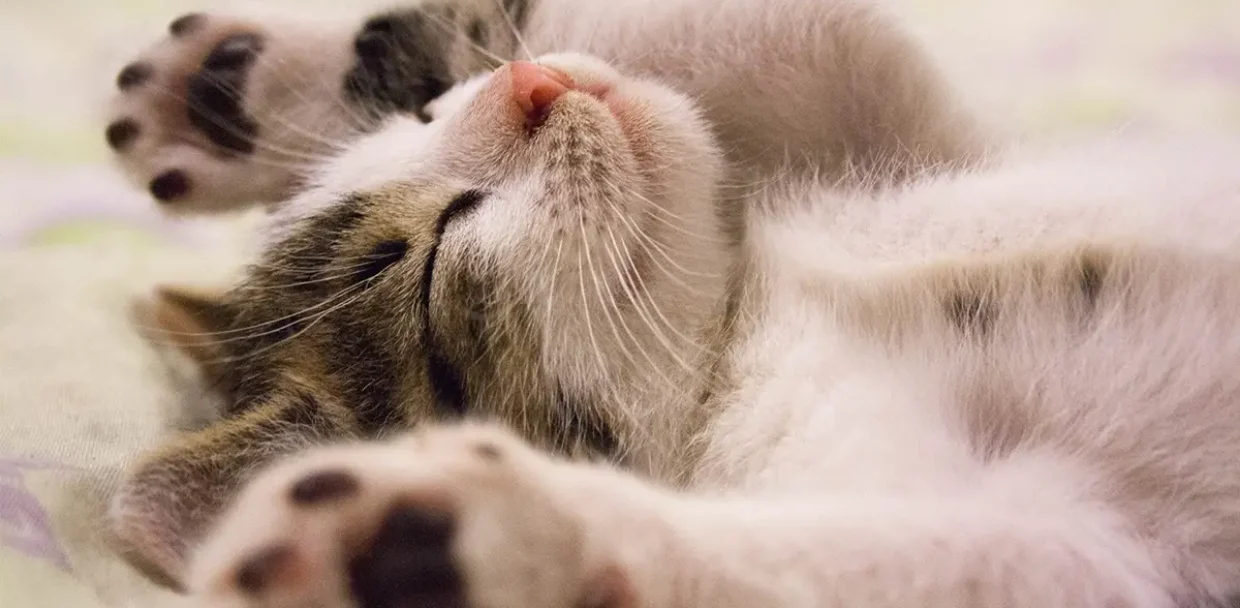Cats are quite vocal animals and are capable to make up to 100 types of vocals. The vocalization of the cat can mean anything. Cat express their emotions, their discomfort, and their pain through vocalizing different sounds. The sounds can vary from meows, trills, hisses, growls, and many more.
 Usually a happy cat purr in a relaxed stance with its eyes half-closed and a still tail. You might notice them doing so when they lay beside you on your bed, get their favorite food, meet another cat, or when they clean themselves. So, when your cat is purring you can assume that your cat is giving a big smile.
Usually a happy cat purr in a relaxed stance with its eyes half-closed and a still tail. You might notice them doing so when they lay beside you on your bed, get their favorite food, meet another cat, or when they clean themselves. So, when your cat is purring you can assume that your cat is giving a big smile.
Also Read: Why do Cats Trill?One of the sounds that cats often make and is quite enchanting and mysterious is vibration or many usually call it purring. This sound is usually associated with a positive response from the cat. So, many cat owners feel contented when their feline friends make this sound when they are together. Those who do not spend a lot of time might not be aware of cats purring and might not have heard it. In this blog, we are going to talk all about purring and the different reasons behind it.
What is Purring?
Purring is one of many sounds that a cat can make. When purring cats use both their larynx and diaphragm muscles when inhaling and exhaling. This behavior and the mechanisms of how the contraction is controlled by the central nervous system are still yet to be known. It is also believed that cats that can purr cannot roar and vice versa. The difference lies in the small bone found inside their vocal cords. In roaring cats, the bone is flexible while in domestic cats, this bone is completely hardened and can only allow air vibrations when breathing. Although the purring of the cat is associated with a positive response of the cat, it is not proven so. Some cats tend to purr when they are in pain or in any sort of discomfort. And the most fascinating thing is that the purring of the cat has the ability to regenerate bone. REGENERATING BONE!!!!! Isn’t it quite mind-blowing?Reasons Why Cats Purr?
A cat can purr for different reasons. The reason may not always be because your cat is happy or relaxed but it can be a negative response as well. It is much more than just an indication of happiness. Here we have mentioned the reasons why cats may purr.Happy Response
Purring is the same as smiling for the cats. When the cat is happy it will express its happiness by purring. You will be able to tell whether your cat is happy or content by the stance it is standing when purring. Usually a happy cat purr in a relaxed stance with its eyes half-closed and a still tail. You might notice them doing so when they lay beside you on your bed, get their favorite food, meet another cat, or when they clean themselves. So, when your cat is purring you can assume that your cat is giving a big smile.
Usually a happy cat purr in a relaxed stance with its eyes half-closed and a still tail. You might notice them doing so when they lay beside you on your bed, get their favorite food, meet another cat, or when they clean themselves. So, when your cat is purring you can assume that your cat is giving a big smile.
To Calm Themselves
Purring has a calming effect on the cat and is fascinating enough to humans as well. The cat has the ability to soothe and calm itself in the case of pain and a stressful environment. You might notice your cat purring in a stressful environment like when giving birth or visiting the vet One of the reasons behind such behavior is believed it is formed when the cat is still a kitten. When the kitten is born they are usually blind and deaf. The purring from their mother helps the kitten to find its mother and nurse on its mother teat. As they grow older, they imitate this behavior and calm themselves. The purring create low-frequency vibrations which ease their breathing and soothes their tension.Hungry
Cat wants to be fed in time. If it is not fed in time then it vocalizes to garner your attention. Among those vocalizations, purring might also be included. The purring is combined with the unpleasant crying of your cat. If you hear your cat vocalizing and creating a purring sound then your cat is telling you to feed them. So, don’t ignore the purring thinking that your cat is happy but rather check whether you have fed your cat or not. Don’t worry you would be able to hear whether it is a happy purr or a hungry purr.Self Healing
Cats’ purr is capable of promoting self-healing and soothing themselves. There is no scientific explanation behind such behavior of the cat but it is proven to have such ability. The biological process that takes place when the cat hums or purrs is the main reason behind such ability. When the whole body of the cat vibrates when purring it results in stimulating the muscles and supporting bone growth. This is one of many reasons believed why cats rarely have broken bones. Different doctors and physiotherapists apply this principle to treat bone injury. When treating the injured bones or the muscles, vibrations with a frequency of 15 to 60 hertz is sent to strengthen those part. This method has also been considered meaningful and useful in the medical field.To Communicate
As mentioned above cats vocalize to communicate. One of the common ways that cats communicate is by purring. They purr to attract their owner’s attention. They have learned this behavior from their mother cat when they are young as a part of the bonding process for them. If your cat is purring when it is laying on your lap or when you are around it then it is because it loves your company and expressing its happiness.What if my Cat doesn’t Purr?
You might have a question in mind like why my cat doesn’t purr. Well, the chances are your cat is purring in a low voice that cannot be heard easily. The sound of the cats purring may vary from cat to cat. Some might have a loud purr whereas some might purr in a low voice. You can only tell the cat is purring by touching its throat or neck to feel the vibration of its purring. Another chance is that you might have a cat that doesn’t purr like feral cats. This breed of cats do not purr. It is believed that the mother feral cats do not encourage their kittens to prevent them from being attacked by predators. So, due to these various reasons, some cats might be purr whereas some won’t.In Short,
Cats purring is not only associated with the positive response of the cat rather it can be their negative responses well. A cat’s vocalization can tell a lot about the cat’s physical and mental condition. So as a cat owner, it is important to take note of your cat’s vocalization. This way you and your cat can both stay happy.You might want to read: Why Do Cats Meow So Much?




